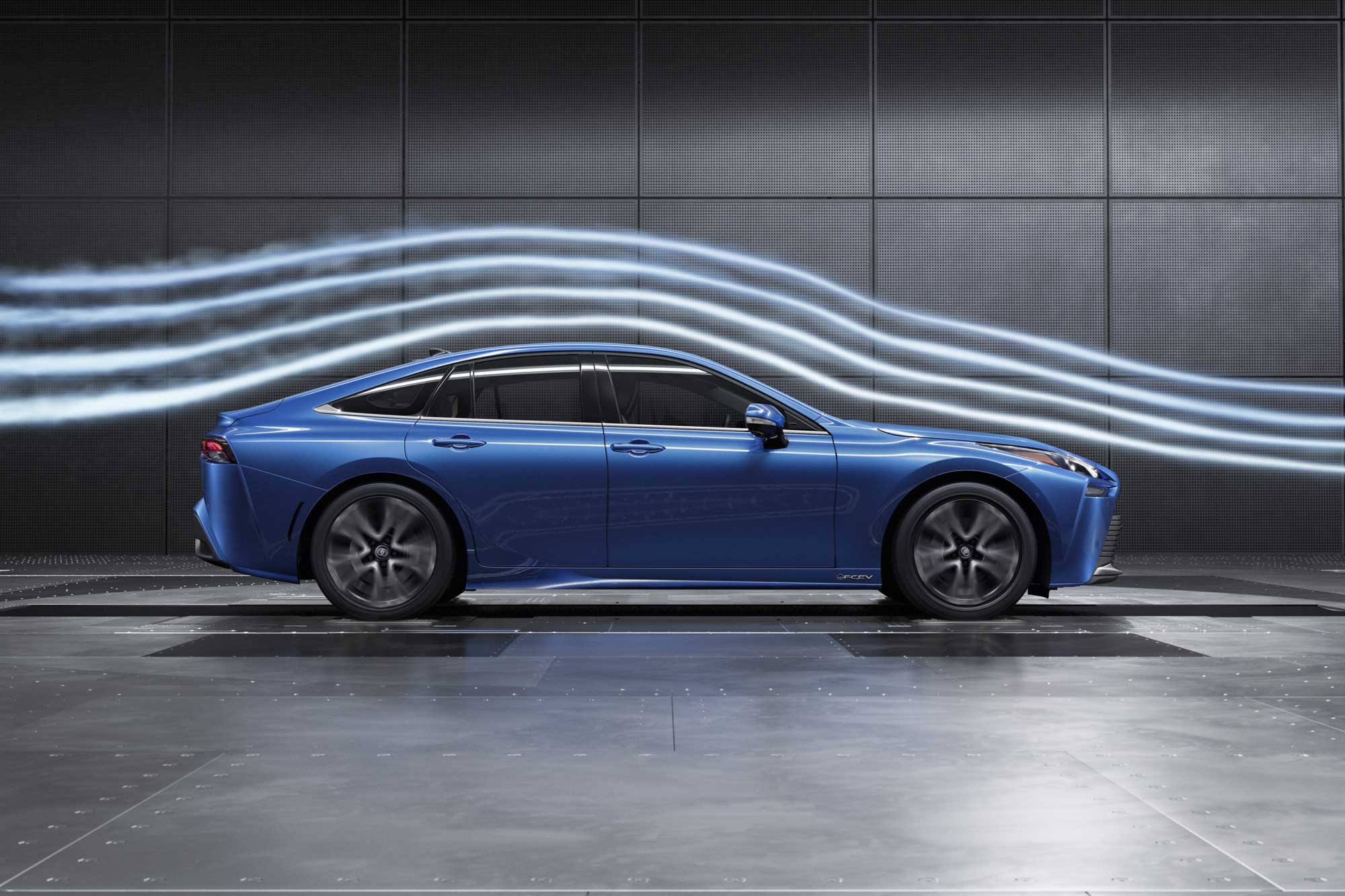Infrastructure for EVs and Hydrogen Vehicles: Which Is More Difficult to Build?
Electric cars have one major advantage: We already have electricity almost everywhere.
 Toyota
Toyota
QuickTakes:
- Engineers are in the process of advancing electromechanical technology
- Battery-electric vehicles have the advantage over hydrogen fuel
- Hydrogen fuel-cell vehicles face several challenges for widespread adoption
- Costs for stations are impractical and include structure limitations
- Infrastructure comes at a cost for both EV options
Building a new fueling infrastructure for any type of vehicle can be tough. It took years for a global network of service stations to be built after the debut of gasoline-powered vehicles, leaving early auto owners with cause for range anxiety similar to electric-vehicle (EV) drivers.
In the transition to vehicles without tailpipes, it's worth considering the difficulty of building the infrastructures needed for the zero-emissions contenders — battery-electric and hydrogen fuel-cell vehicles.
 Toyota
Toyota
Engineers Are in the Process of Advancing Electromechanical Technology
Auto engineers invent complex electromechanical technology and refinine it over many iterations to be smaller, more technologically advanced, and powerful. That process has been underway for battery-electric vehicles through research into solid-state batteries. It seems likely that engineers could do the same for hydrogen fuel-cell vehicles too, given sufficient time and money.
But that's only half the battle. The biggest challenge for either type of zero-emission vehicle generally isn't the vehicle itself; it's the fueling (or charging) network.
 Toyota
Toyota
Battery-Electric Vehicles Have the Advantage Over Hydrogen Fuel
One great advantage to battery-electric vehicles is that electricity in the United States is widely available. It might not have enough power to recharge batteries speedily, or it might not have the right connectors attached to it yet, but the starting point for recharging an EV is relatively proximal to where many U.S. vehicles may park, which is not the case for hydrogen fuel.
According to a study on EVs by auto news outlet Charged EV Fleet and Infrastructure News, four out of five U.S. households that have the income to buy a new car also have dedicated off-street parking. That means that if those buyers go electric, they will likely do most of their charging overnight at home. Their electric utilities may incentivize off-peak charging by lowering rates between certain times and raising them during times of higher demand.
Charging can be more difficult for drivers who live in apartment buildings, condos, or other multiple-unit dwellings, and for those who park on the street or don't have a permanent parking space.
Charging stations are sometimes offered as an amenity at high-end multiple-unit dwellings, but it may take a while for them to become widely available. In the meantime, these drivers might need to go to public charging stations a few times a week — or leave their EVs overnight — to recharge.
With the exception of the exclusive Tesla network, public charging networks keep a variety of software and hardware communicating properly — including charging stations, the cars being charged, and the financial institutions that process payments.
The reliability of non-Tesla charging networks may not be equipped for a burgeoning EV transition. Even so, battery-electric has a head start over hydrogen. U.S. electric utilities are largely experienced at providing reliable service, as well as upgrading grids and infrastructure to handle new demands as they emerge.
 Toyota
Toyota
Hydrogen Fuel-Cell Vehicles Face Several Challenges for Widespread Adoption
Unlike electricity, hydrogen is not as accessible — at least not in a usable form for EVs. Scientists report that hydrogen is the most abundant element in the universe, but hydrogen gas has an extremely high propensity to bond with other substances, giving off energy in the process. That's how a hydrogen fuel cell works: The hydrogen bonds with oxygen from the air to produce electricity and water vapor.
The challenge is that a lot of energy is needed to crack a more complex molecule — typically natural gas — to make pure hydrogen. This process is used for industrial needs at large chemical plants. Hydrogen pipelines also carry the gas to locations for use in high volumes.
But those pipelines are quite different from a retail fueling network that can refill cars the way gas stations or even EV charging stations can. The only large U.S. experiment in providing such a network of hydrogen stations has been underway in California since 2013. That's when the residents of the state taxed themselves about $100 million under Assembly Bill 8 to pay for clean-car fueling infrastructure, aiming to establish 100 hydrogen stations by the end of 2020.
As of July 2024, 66 are operational.
Costs for Stations Are Impractical and Include Structure Limitations
Those stations can be expensive. A 2019 assessment by the California Energy Commission noted that it cost $120 million to build 43 operational stations plus another 20 that were still under construction at the time. That's roughly $2 million each.
Given their complexity, these stations have some operational limitations and are a challenge to keep in working order. The real-time Station Status app operated by the Hydrogen Fuel Cell Partnership tracks how many California stations are up and running properly at any moment. One of the challenges is that hydrogen must be pumped into vehicles where it will be stored under high pressure (up to about 10,000 pounds per square inch). That requires aircraft-grade hardware, with a heavy nozzle that must be locked onto the vehicle to withstand the pressure. Because hydrogen gas must be stored at very low temperatures, ice can also form on nozzles.
Additionally, the stations don't always serve numerous vehicles back to back. Some stations can fill only a handful of cars before they must repressurize themselves to the necessary level, which can take time. Some planned hydrogen networks would be able to serve only a fraction of the number of fuel-cell cars needed to compete with current EVs. For example, if California ended up with a network of 75 stations, that would be enough to serve an estimated 17,000 to 24,000 hydrogen fuel-cell vehicles.
The supply of hydrogen to those stations generally comes largely from industrial hydrogen production, which is derived almost entirely from natural gas (though a certain proportion of it must be defined as renewable under California Air Resources Board rules). The current supply is vulnerable to disruption, as evidenced in June 2019 when a hydrogen facility in Santa Clara halted supply to nine of the San Francisco Bay Area's 11 hydrogen stations after an explosion. The shortage lasted several months, influencing Toyota to help Mirai customers find alternative fueling options and address their concerns directly.
Compare all of this to the more than 145,000 fueling stations that serve internal-combustion-engine vehicles across the U.S. and you get a sense of the size of the challenge hydrogen faces for large-scale adoption of fuel-cell vehicles.
Infrastructure Comes at a Cost for Both EV Options
Both battery-electric EVs and hydrogen-powered vehicles will require substantial new infrastructure, which may cost tens of billions of dollars, but electric has the clear edge.
Electricity is available at a wide majority of parking lots, although in many cases it is not free. For those who park at home, plugging in at the end of the day can be a convenient option to justify the cost.
Written by humans.
Edited by humans.
 John Voelcker
John VoelckerJohn Voelcker is a reporter and analyst covering electric vehicles, auto technology, and energy policy. He has written or edited more than 12,000 articles on low- and zero-emission vehicles and the energy ecosystem around them. His work has appeared in print, online, and radio outlets, and he is frequently quoted as a subject-matter expert. He splits his time between the Catskill Mountains and New York City, and still one day hopes to become an international man of mystery.
Related articles
View more related articles